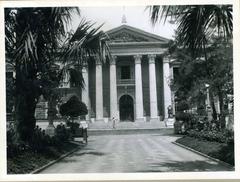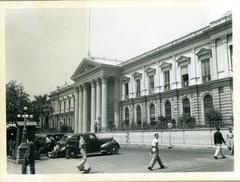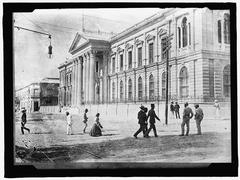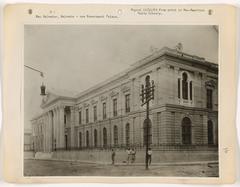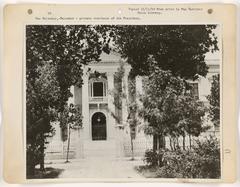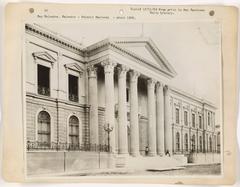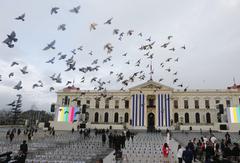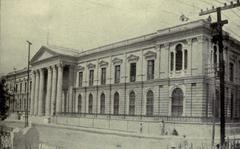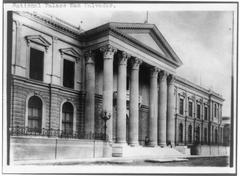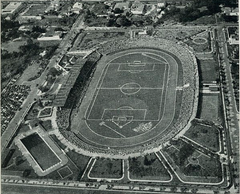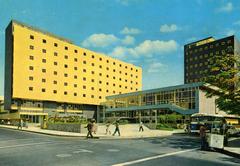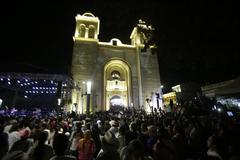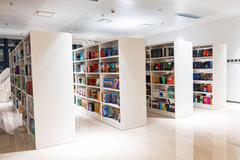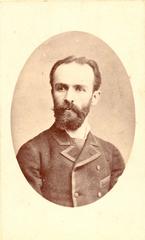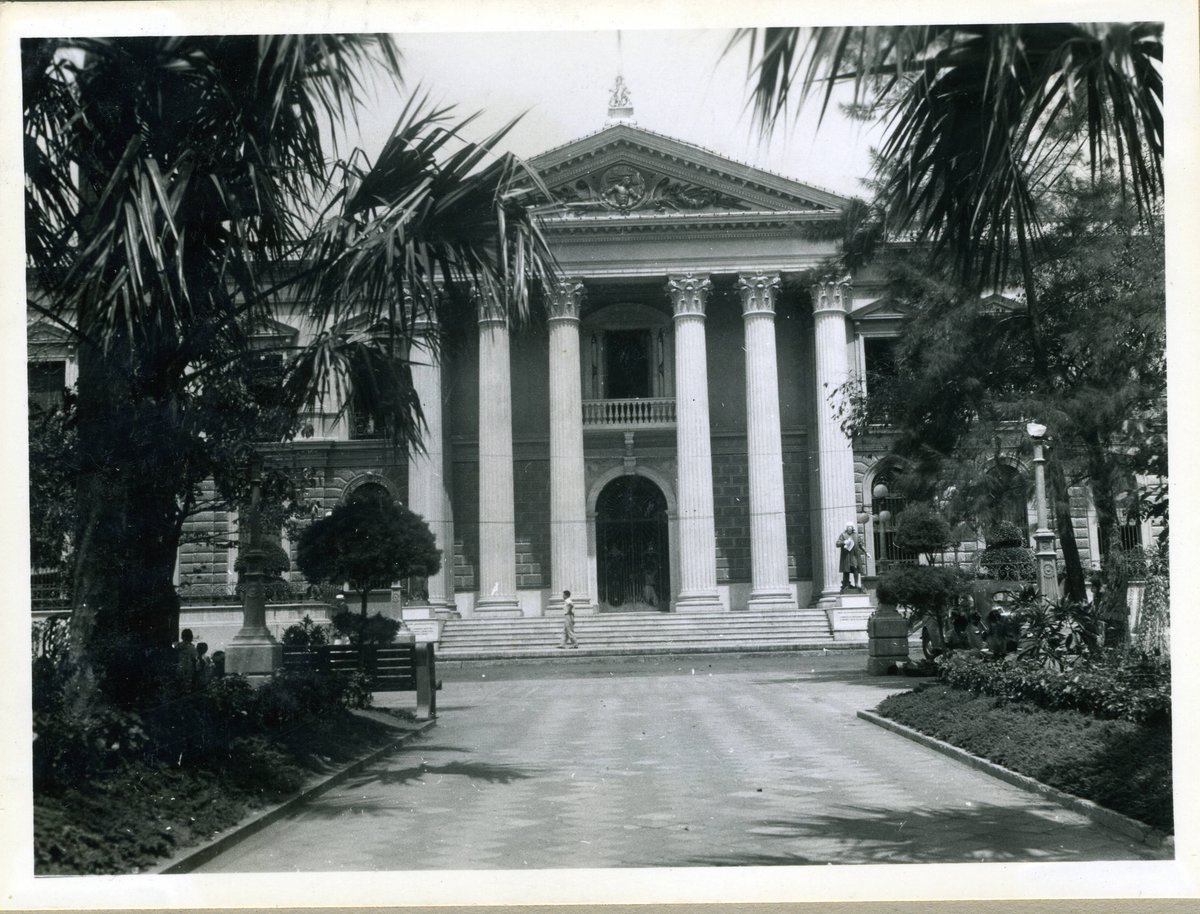
National Palace San Salvador: Visiting Hours, Tickets, and Historical Sites Guide
Date: 14/06/2025
Introduction
Nestled in the heart of San Salvador’s historic downtown, the National Palace (Palacio Nacional de El Salvador) stands as a magnificent symbol of El Salvador’s cultural heritage, political history, and architectural grandeur. Built in the early 20th century with funds from coffee exports, this landmark reflects both the nation’s economic backbone and its aspirations for modernity (Alluring World). The palace’s fusion of Neo-Gothic, Neoclassical, and Renaissance styles—along with imported European decorative elements—underscores the country’s desire to showcase sophistication during its nation-building era (stephenhgrant.com).
Today, the National Palace is not only a historic seat of government but also a living museum and cultural hub. Its central location, accessibility, and proximity to other iconic sites such as the Metropolitan Cathedral and Plaza Barrios make it a must-visit for anyone exploring San Salvador’s vibrant historic center (elsalvadorinfo.net; Now Go See It). This guide provides all the essential information about visiting hours, tickets, guided tours, practical travel tips, and the palace’s historical and cultural significance.
Contents
- Overview of the National Palace
- Historical Evolution
- Architectural Highlights
- European Influences
- Façade and Exterior
- Interior and Ceremonial Rooms
- Decorative Arts
- Cultural and Political Significance
- National Identity and Statehood
- Political Events and Civic Life
- Cultural Engagement
- Preservation and Memory
- Visiting the National Palace: Practical Information
- Opening Hours and Tickets
- Accessibility
- Guided Tours
- Best Times to Visit
- Nearby Attractions
- Visitor Tips
- San Salvador’s Historic Downtown: Context and Key Landmarks
- Frequently Asked Questions (FAQ)
- Visuals and Internal Links
- References
Discover the National Palace of San Salvador
The National Palace is a striking emblem of El Salvador’s identity. Built between 1905 and 1911, it replaced the original 19th-century palace destroyed by fire in 1889. The new palace was envisioned as a grand, modern seat of power and national pride, funded by a tax on coffee exports—a testament to coffee’s importance in Salvadoran society (Alluring World).
Since its completion, the palace has served as the meeting place for various branches of government and as a venue for state ceremonies, diplomatic receptions, and public events. Its ongoing role as a civic and cultural hub reflects the nation’s evolving story.
Architectural Highlights
Eclectic European Influences
The palace’s design incorporates Neo-Gothic, Neoclassical, and Renaissance elements. Imported tiles and decorative motifs from Germany, Italy, and Belgium contribute to its distinctive style and elegance.
Façade and Exterior
The main entrance is framed by six imposing columns and flanked by statues of Christopher Columbus and Isabella I of Castile—gifts from King Alfonso XIII of Spain in 1924. These features reinforce El Salvador’s colonial history and cultural ties to Spain.
Interior and Ceremonial Rooms
The palace houses 104 rooms, each with unique floor and ceiling designs. Four main ceremonial salons are especially notable:
- Red Room (Salón Rojo): Used for presidential inaugurations and diplomatic ceremonies.
- Yellow Room (Salón Amarillo): Former presidential office.
- Pink Room (Salón Rosado): Once home to the Supreme Court and Ministry of Defense.
- Blue Room (Salón Azul): Legislative Assembly chamber since 1906.
These spaces showcase intricate tilework, European furnishings, and period decorations.
Decorative Arts
The palace’s interiors are adorned with vibrant tiles, geometric designs, and elegant marble staircases. Imported materials and fine craftsmanship were chosen to symbolize national ambition and international relevance.
Cultural and Political Significance
National Identity and Statehood
The National Palace’s imposing neoclassical façade projects authority and stability, anchoring the Salvadoran state’s identity during its formative years (earth-site.co.uk).
Political Events and Civic Life
Throughout its history, the palace has hosted legislative sessions, court proceedings, and diplomatic receptions. It has been a silent witness to political transitions, civil conflict, and peace-building, providing continuity during turbulent times (stephenhgrant.com; mattsnextsteps.com).
Cultural Engagement
Beyond politics, the palace regularly hosts art exhibitions, national celebrations, and educational programs. Its accessibility and guided tours promote civic education and connect visitors with Salvadoran heritage (earth-site.co.uk).
Preservation and Memory
Designated a National Historic Landmark in 1974, the palace’s ongoing restoration ensures its preservation for future generations. The 1889 fire that destroyed the original palace is a reminder of the fragility of historical memory and the importance of heritage conservation (stephenhgrant.com).
Visiting the National Palace: Practical Information
Opening Hours and Tickets
- Hours: Tuesday to Sunday, 9:00 AM – 4:00 PM (closed Mondays and some public holidays)
- Admission:
- Salvadoran citizens: $1 USD
- Central American visitors: $3 USD
- Foreign visitors: $5 USD
Ticket prices may change; check current rates before your visit (Now Go See It).
Accessibility
The palace is equipped with ramps and elevators for visitors with disabilities. Contact the administration in advance to confirm specific accommodations.
Guided Tours
- Required: All visitors must join a guided tour; self-guided visits are not permitted.
- Languages: Tours are conducted in Spanish. Arrange for a bilingual guide or translator if needed.
- Duration: Approximately 45–60 minutes, covering the main salons, courtyards, and historical exhibits (Adventure Backpack).
Best Times to Visit
Weekday mornings are quieter, offering a more relaxed experience. Peak times include weekends, holidays, and during cultural events. Advance booking is recommended for groups and during festivals (Lonely Planet).
Visitor Tips
- Language: Staff and guides speak Spanish; basic Spanish or a translation app is helpful.
- Safety: The historic center is safe during the day, with increased police presence around major landmarks. Use standard travel precautions (Nomadic Matt).
- Dress Code: Wear comfortable, modest clothing and sturdy shoes for walking on marble and tile floors.
- Photography: Allowed in most areas (no flash or tripods unless permitted).
- Facilities: Restrooms and a small gift shop are available; nearby cafes and shops offer refreshments.
San Salvador’s Historic Downtown: Context and Key Landmarks
San Salvador’s “Centro Histórico” is anchored by the National Palace and includes:
- Plaza Gerardo Barrios: The main civic square, often the site of festivals and parades.
- Metropolitan Cathedral: The city’s principal Catholic church, adjacent to the palace (elsalvadorinfo.net).
- National Theater: El Salvador’s oldest theater, renowned for its architecture (adventurebackpack.com).
- El Rosario Church: Famous for its modernist design and vibrant stained glass.
- Liberty Plaza: A central venue for independence celebrations.
- Mercado Central: Bustling market for crafts and local cuisine (onetravel.com).
The area is compact and best explored on foot or via guided walking tours.
Frequently Asked Questions (FAQ)
Q: What are the National Palace visiting hours?
A: Tuesday to Sunday, 9:00 AM – 4:00 PM; closed Mondays and some holidays.
Q: How much are tickets?
A: $1 USD for Salvadoran citizens, $3 USD for Central Americans, $5 USD for other foreigners.
Q: Are guided tours available in English?
A: Currently, tours are in Spanish only; arrange a translator if needed.
Q: Is the palace accessible to visitors with disabilities?
A: Yes, with ramps and elevators; contact ahead for details.
Q: Can I take photographs inside?
A: Yes, in most public areas, but avoid flash and tripods unless permitted.
Q: Do I need to book in advance?
A: Advance booking is recommended for groups and during busy seasons.
Visuals and Internal Links
Include high-quality images of the National Palace’s façade, interior salons, murals, courtyards, and a map with descriptive alt text such as “National Palace San Salvador exterior,” “Blue Room at National Palace,” and “Murals inside National Palace.”
Internal links:
References
- Alluring World: National Palace
- Stephen H. Grant: San Salvador’s National Palace
- Now Go See It: Things to Do in San Salvador
- El Salvador Info: San Salvador Historic Downtown
- Adventure Backpack: San Salvador Highlights
Final Recommendations
The National Palace of San Salvador is a captivating destination that encapsulates the nation’s history, culture, and architectural splendor. With affordable entry, insightful guided tours, and a strategic location among San Salvador’s top historical sites, it offers a rewarding experience for visitors of all backgrounds. Don’t miss the opportunity to explore this national treasure—plan ahead, take advantage of local tours, and immerse yourself in the vibrant culture of El Salvador’s historic downtown (Alluring World; Adventure Backpack; elsalvadorinfo.net).
For more travel tips and updates, download the Audiala app, follow us on social media, and visit our website for interactive guides and exclusive content about El Salvador’s heritage.
